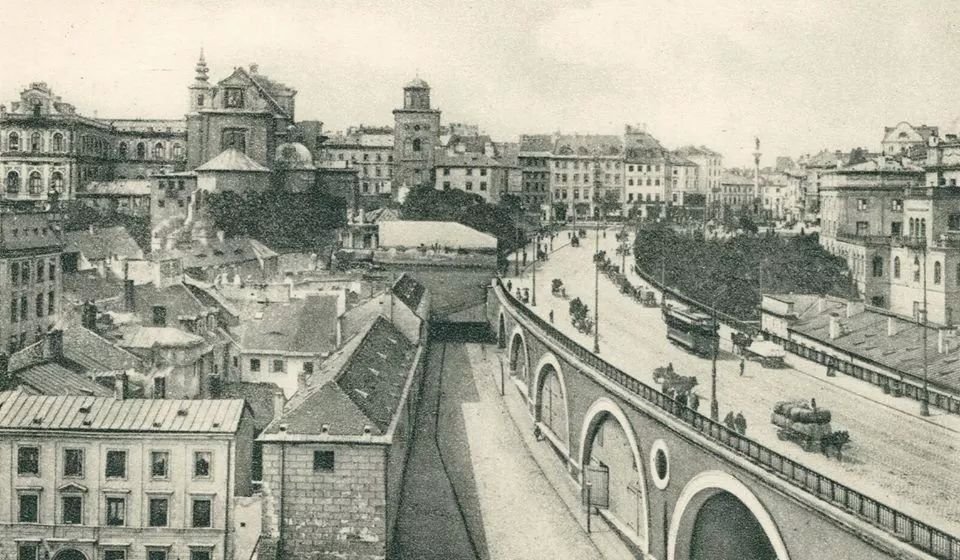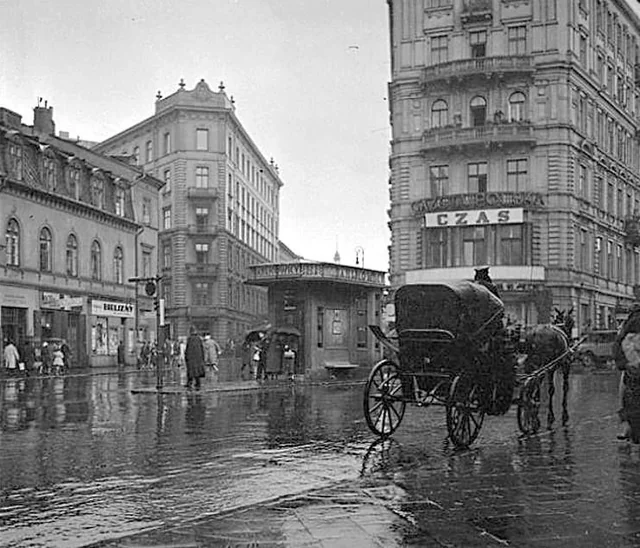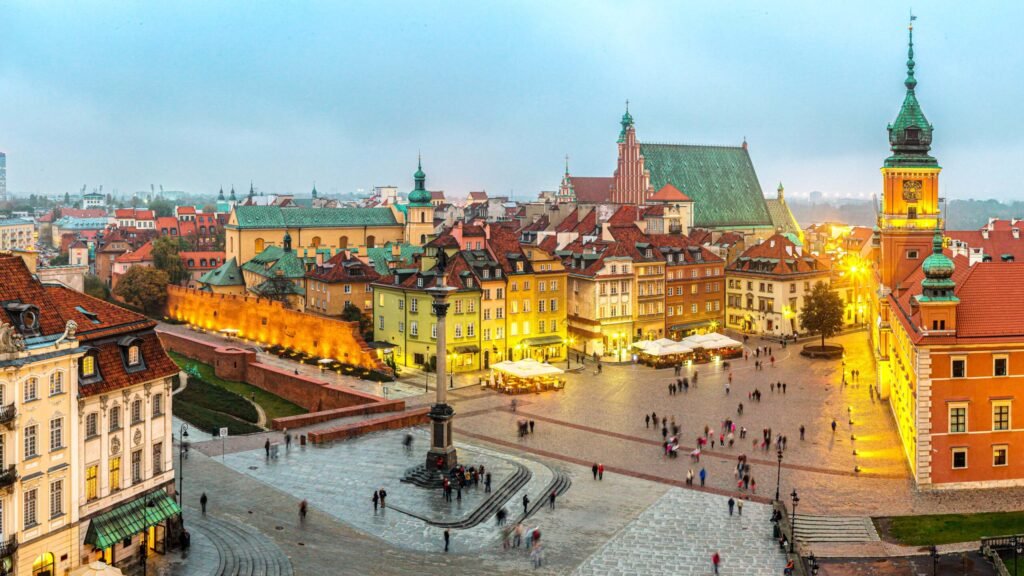Warsaw Then and Now
Warsaw Then
The name of Warsaw, the capital city of Poland, has an uncertain origin and has been the subject of various hypotheses and folk tales.
The most widely accepted theory suggests that “Warszawa” is derived from the Old Polish name “Warcisław,” with the city name indicating “belonging to Warsz,” a shortened form of this name.
This etymology links Warsaw with other Polish cities like Wrocław, which share similar root elements. However, the “-awa” ending is unusual for large Polish cities, as most city names derived from personal names end in “-ów,” “-owo,” or “-ew.”
Another popular explanation is based on folk etymology, which connects the name to a legend about a fisherman named Wars and a mermaid named Sawa.

According to this legend, Wars fell in love with Sawa, who lived in the Vistula River, and this romantic tale became intertwined with the city’s name.
Despite the uncertainty of its true origin, the official full name of the city is “miasto stołeczne Warszawa,” meaning “The Capital City of Warsaw.”
Related Article: Budapest Then and Now
Warsaw History
Warsaw, the capital city of Poland, has a rich and complex history that spans over a thousand years.
The earliest traces of human settlement in the area date back to the 10th and 11th centuries, with evidence of a small trading settlement called Stare Bródno.
Over time, settlements such as Kamion and Jazdow emerged, with Jazdow being moved in the late 13th century to a location that would eventually be known as Warszawa (Warsaw).
This settlement was fortified with the construction of a castle, signaling the city’s growing importance.
Related Article: Prague Then and Now
By the 14th century, Warsaw had developed into a significant urban center, with its own city council and protective ramparts.
In the 15th century, Warsaw became the capital of the Duchy of Mazovia.
The city’s importance grew further in the 16th century when, in 1526, it was incorporated into the Kingdom of Poland.
Warsaw’s role as the political heart of Poland strengthened when the Sejm (parliament) convened there in 1569, and by 1573, the elections for Polish kings were held in the city.
Related Article: Vienna Then and Now
The construction of the first permanent bridge across the Vistula River in 1573 and the remodeling of the Royal Castle by King Sigismund III Vasa in 1596 further solidified Warsaw’s status as a key Polish city.
The move of the royal court from Kraków to Warsaw in 1611 made it the formal capital of the Polish state.
However, Warsaw’s prosperity faced setbacks. The Swedish invasion of 1655–56 severely damaged the city, and the War of the Polish Succession (1733–38) brought economic decline.
Despite these challenges, Warsaw experienced a cultural revival in the 18th century under King Stanisław II August Poniatowski, who promoted the Polish Enlightenment.
Related Article: Athens Then and Now
The city became a center for education, theatre, and printing, and played a significant role in Poland’s political life, especially during the creation of the Polish Constitution in 1791.
After the third partition of Poland in 1795, Warsaw became part of Prussia but regained its status as a capital when Napoleon established the Duchy of Warsaw in 1807.
However, after Napoleon’s defeat, Warsaw fell under Russian control.
Throughout the 19th century, Warsaw witnessed significant political turmoil, including uprisings like the November Insurrection of 1831 and the January Insurrection of 1863.
Related Article: Rome Then and Now

Despite periods of Russification and military rule, Warsaw continued to grow economically, becoming an industrial hub with textile, metal, and tannery industries. The city’s population swelled, and by 1903, it reached 756,000.
The early 20th century saw Warsaw emerge as a cultural center in Europe, with international competitions like the International Chopin Competition for Pianists and the Henryk Wieniawski International Violin Competition.
World War II marked a devastating period in Warsaw’s history. The city was heavily bombed and besieged in 1939, with over 10,000 people killed and 50,000 wounded.
The subsequent Nazi occupation led to the establishment of the Warsaw Ghetto, where tens of thousands of Jews were deported to death camps.
Related Article: Barcelona Then and Now
The Warsaw Ghetto Uprising of 1943 became a symbol of resistance, but the city was further destroyed during the Warsaw Uprising of 1944, in which up to 180,000 people died.
By the end of the war, Warsaw lay in ruins, with its population decimated and its cultural heritage plundered.
After the war, Warsaw was rebuilt from the ground up. It regained its status as the capital of Poland in 1945, and a massive reconstruction effort began.
The city gradually expanded, and by the late 20th century, Warsaw emerged as a modern metropolis.
Related Article: Amsterdam Then and Now
With the fall of communism in 1989, Warsaw transitioned from a centrally planned economy to a market-driven one.
The city underwent a construction boom, attracting foreign investment and transforming its skyline with new office buildings and hotels.
Today, Warsaw stands as a thriving capital, balancing its rich historical heritage with modern developments.
Despite challenges in the past, including political tensions and periods of economic struggle, Warsaw continues to be an important cultural, political, and economic center in Europe.
Related Article: Berlin Then and Now
Warsaw Now

Warsaw, the capital and largest city of Poland, is located on the Vistula River in east-central Poland.
With a population of approximately 1.86 million within the city limits and a larger metropolitan area of 3.27 million, it is the 7th most populous city in the European Union.
Covering an area of 517 square kilometers, Warsaw is divided into 18 districts, and its metropolitan region spans over 6,100 square kilometers.
Related Article: Paris Then and Now
The city plays a crucial role as a political, cultural, and economic center, making it an important hub not only for Poland but also for Central and Eastern Europe.
As the capital of the Masovian Voivodeship, it is home to key national institutions, including the seat of government.
The city’s infrastructure is well-developed, with two international airports: Warsaw Chopin Airport, which is the busiest, and the smaller Warsaw Modlin Airport catering to low-cost carriers.
Related Article: London Then and Now
Warsaw also boasts a comprehensive public transportation system, including the Warsaw Metro, buses, commuter trains, and a widespread tram network.
As a significant economic powerhouse, the city hosts the Warsaw Stock Exchange, the largest in Central and Eastern Europe, and serves as the base for prominent institutions like Frontex, the European Union agency for external border security, and ODIHR, an institution of the Organization for Security and Co-operation in Europe.
Warsaw’s skyline is one of the most impressive in Europe, with a high concentration of skyscrapers, and it is home to the tallest building in the European Union, the Varso Place.
Related Article: Phnom Penh Then and Now
Culturally, Warsaw is a center of education, with notable institutions such as the University of Warsaw, the Warsaw University of Technology, and the Chopin University of Music.
The city is also known for its rich cultural heritage, including its National Philharmonic Orchestra, National Museum, and the Warsaw Grand Theatre, the largest of its kind in the world.
The city’s Old Town, which was painstakingly reconstructed after World War II, is a UNESCO World Heritage Site and showcases a variety of European architectural styles.
Related Article: Kathmandu Then and Now
Landmarks like the Royal Castle, Sigismund’s Column, Wilanów Palace, and the Royal Route contribute to the city’s historical significance and beauty.
In addition to its architectural and cultural offerings, Warsaw is a green city with around a quarter of its area dedicated to parks.
This balance of urbanization and natural spaces makes Warsaw an attractive and livable city.
Related Article: Colombo Then and Now
The city’s sports culture is vibrant, with Legia Warsaw football club being a major team, and the annual Warsaw Marathon attracting participants from around the world.
Overall, Warsaw is a dynamic and resilient city that blends its rich history with modernity, making it a major player in Europe.
Related Article: Dhaka Then and Now
FAQs
Warsaw is famous for its rich history, cultural heritage, and resilience. It is Poland’s capital and a major economic, political, and cultural hub in Central Europe.
Notable landmarks include the Royal Castle, Old Town (a UNESCO World Heritage site), and the Warsaw Uprising Museum, commemorating the city’s heroic resistance during World War II.
Compared to other European capitals, Warsaw can be considered relatively affordable.
While living costs, including rent and dining out, are lower than in cities like London or Paris, prices have been rising in recent years due to economic growth and increasing tourism.
The official language spoken in Warsaw is Polish. English is also widely understood, especially among younger generations and in tourist areas, but learning a few basic Polish phrases can be helpful for visitors.
Yes, Warsaw is worth visiting. It offers a blend of history, modern architecture, vibrant cultural life, and green spaces.
The city’s rich museums, historical sites, and thriving food and arts scenes make it a captivating destination for tourists.






























